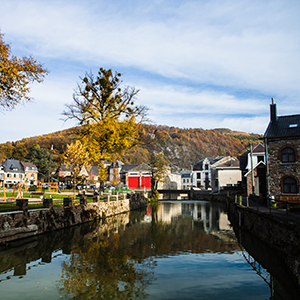Natural reserves and protected landscapes
Champalle National Reserve (Houx)
51 hectares, limestone cliffs (south-west facing), the northernmost site for southern plants, coppice with standards, boxwoods and limestone lawns. A footpath leads through this protected natural area: it crosses the wooded plateau and goes along the edge of the cliff.
The Plaine du Moulin site (Evrehailles)
wonderful panoramic views of the countryside going down from Evrehailles towards Bauche. Listed for its aesthetic and historic value in 1977. Come to admire, paint and take photographs of the Bocq combes, the seasonal colours, the typical Condroz landscape with its pleasant, harmonious combination of farms, woods, fields and grasslands.
The 3 Godinne islands
at the foot of the Tienne de Rouillon (also known as Mont Pelé) which is famous for its dry grass, in the Meuse Valley where the river crosses the anticline formed by red rocks in the Burnot bedrock. These 3 islands are not open to the public, in order to protect the plants and animal wildlife. They now have typical river vegetation (study conducted in the spring of 1991 by J. Saintenoy-Simon and J. Duvigneaud): alder woods, Aconitum vulparia, Lunaria rediviva, Dipsacus pilosus, Anemones ranunculoides, Thalictrum flavum, Rumex hydrolapathum, etc. These islands are an ornithological nature reserve. Since 1973, many different species have been observed here such as rooks, mallards, gulls, common moorhens, wagtails, geese, and so on. Rarer birds nest here too, such as the great crested grebe, kingfisher, etc. Others find refuge here from time to time, especially in the winter months (during migration) including: the great cormorant, grey heron and Eurasian Coot.
Tricointe National Forest
also known as "Crêtes de Meuse" and "Bois d'Anway", is the property of the Wallonia Region Ministry and extends over 162 hectares. The natural forest environment of the Tricointe is divided up by fields and meadows, creating a diverse landscape. A few plots of conifers (spruce, larch, Norway pine and Douglas fir) form a backdrop for the deciduous populations (oaks, beeches, ashes, hornbeams, maples). These types of trees are suited to the particular kind of soils in the region, on "Burnotien" red sandstone. Brambles and bracken bear witness to the acidic, siliceous nature of the land. There is abundant animal wildlife. If you are patient and quiet, you are likely to encounter roe deer, squirrels, woodpeckers and various birds including birds of prey. Please keep to the footpaths and respect the plants, animals - and hunting periods.
For more information:
Division de la Nature et des Forêts à Dinant, rue Daoust 14 - 082 67 68 80
or call the Tourism Department on 082 61 03 29



